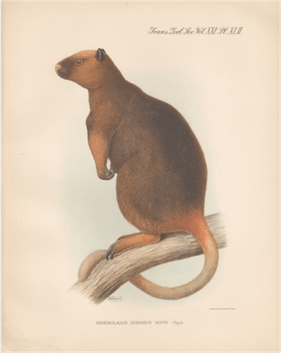Wondiwoi tree-kangaroo facts for kids
Quick facts for kids Wondiwoi tree-kangaroo |
|
|---|---|
 |
|
| Illustration from the 1936 Rothschild and Dollman monograph 'The Genus Dendrolagus' | |
| Conservation status | |
| Scientific classification | |
| Genus: |
Dendrolagus
|
| Species: |
mayri
|
The Wondiwoi tree-kangaroo (Dendrolagus mayri) is a mammal species in the genus Dendrolagus. It was known until recently from a single specimen which was collected in 1928. The only known specimen is a male weighing 9.25 kilograms (20.4 lb). D. mayri was located in the Wondiwoi Peninsula of West Papua at an elevation of 1,600 metres (5,200 ft) within montane forest. It is thought that the Wondiwoi tree-kangaroo could occupy an area of 300 square kilometres (120 sq mi). Global Wildlife Conservation, the wildlife conservation charity, lists the Wondiwoi Tree Kangaroo as one of their "25 Most Wanted Lost Species".
Taxonomy
It was named in honour of Ernst Mayr, who collected the type specimen now deposited in the Natural History Museum, London. It was described by Lord Rothschild and Capt. Guy Dollman in a 1933 paper and an illustration based on the only known specimen was published in their 1936 monograph on the genus.
Discovery
In July 2018, what may prove to be the first ever photographs of the species were taken by British naturalist Michael Smith. Smith was investigating Vireya rhododendrons in an unexplored area of the Wondiwoi ranges and photographed a 'dorianus type' tree kangaroo at an altitude of approximately 1,600 metres. Scent marks, tree kangaroo scat and claw marks at the base of trees made by climbing tree kangaroos were found from 1,700m to 2,000m in steep montane forest. Local hunters, who frequently kill Grizzled tree kangaroos in lowland forest, rarely if ever visit the forest above 1,500m because of the difficult terrain, lack of water sources and dense bamboo thickets.
Status
Long thought to be extinct or critically endangered, the IUCN Red List listed the species as Critically Endangered (Possibly Extinct) because "if the species still exists the population must be very small (less than 50 mature individuals) and probably in decline due to hunting pressures. Although the area has not been well-sampled, there have been a few visits to the area with no reports of this species." In 2018, a British amateur botanist photographed what is believed to be a living specimen of the Wondiwoi tree-kangaroo in the mountains of New Guinea.
The species status of Dendrolagus mayri is uncertain. Some authorities refer to all 'dorianus type' tree kangaroos as subspecies of Doria's tree kangaroo, including Colin Groves, who published a major revision of the taxonomy of the genus in 1982. More recent DNA analysis indicates, however, that the members of the dorianus group deserve species status, although Dendrolagus mayri itself was not included in the study.
See also
 In Spanish: Canguro arborícola de Wondiwoi para niños
In Spanish: Canguro arborícola de Wondiwoi para niños


